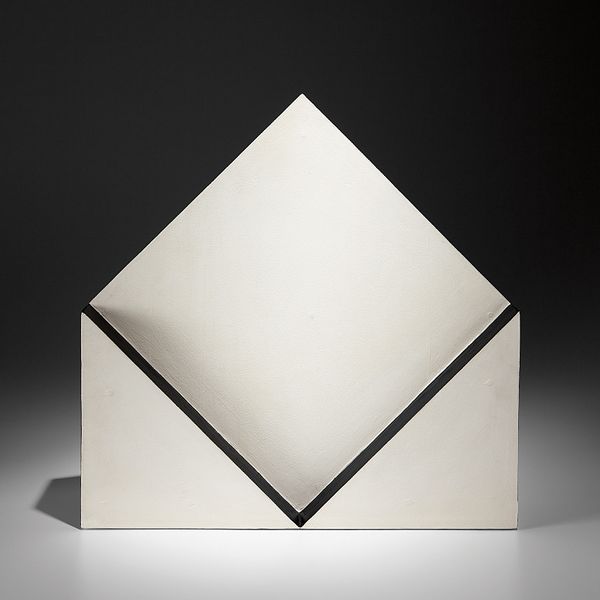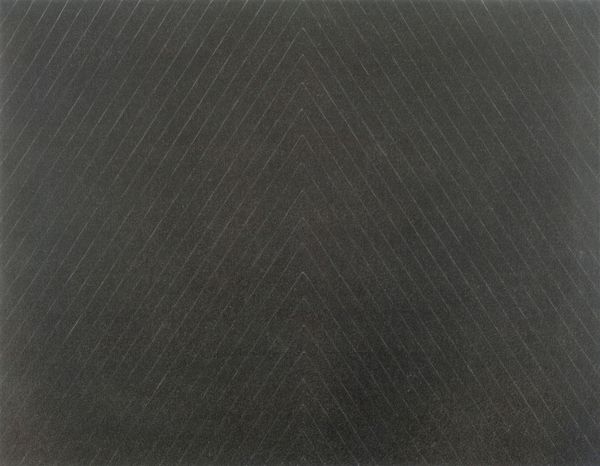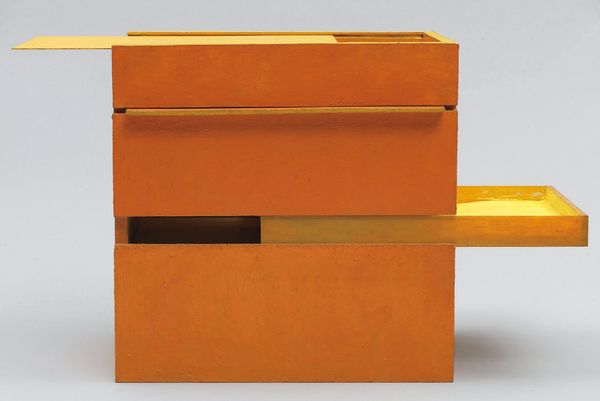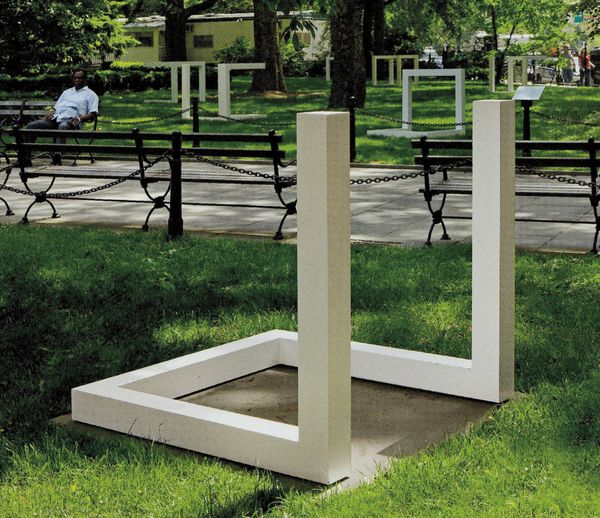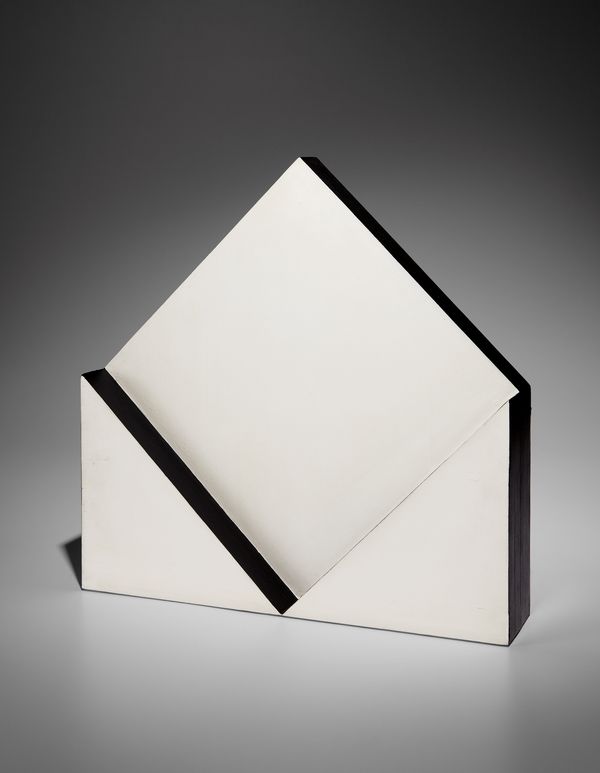Lygia Pape Escultura (Sculpture), 1965
Lygia Pape was a pioneering artist in virtually every stage of her long career. In the early 1950s she joined the Rio de Janeiro Frente group, which together with Ruptura in São Paulo was one of the early exponents of constructivist-oriented and concrete art in Brazil. A signatory to the Neoconcrete Manifesto of 1959, Pape's Tecelares series from that period could be described as having — what Yves-Alain Bois defined as — pseudomorphic relations with contemporaneous works by Frank Stella. That is to say, their respective works, composed of black backgrounds and sequential geometric patterns formed by thin white lines, resemble each other to the point of being almost indistinguishable.
Frank Stella Point of Pines, 1959. Enamel on canvas © 2016 Frank Stella / Artists Rights Society (ARS), New York.
However, neither artist was aware of the other's work and, more importantly, their individual processes, both intellectual and material, remain quite distinct. In the case of Pape's Tecelares, the medium was not enamel on canvas but woodcut prints. As Paulo Herkenhoff argued, in the catalogue for Pape's posthumous international retrospective exhibition Magnitized Space, woodcut prints had until then been associated with Brazilian expressionist artists, with the popular aesthetics of folk-imagery and craft. Thus to compose patterns according to the laws of Gestalt psychology in this culturally charged medium represented a considerable transgression from the premises of geometric abstraction, particularly those professed by concrete art.
Art is my way of understanding the world.
—Lygia Pape
Still, during her participation within the neoconcrete movement she adopted a creative strategy that today could be understood as trans-media, one that is more commonly associated with conceptual art. Her series of 'books', for example, cannot be understood under the traditional sense of the term since they consisted of sequential displays of reliefs in wood or objects in paper or card that did not contain words but were formed of geometric configurations, suggesting but never entirely revealing a narrative. Later, following the dissolution of the neoconcrete group, her work would shift towards the abject, as art historian Fernanda Pequeno argued, in a manner that approached Georges Bataille's notion of the Informe. Order and disgust are thus juxtaposed in a similar transgressive procedure as had taken place with the discrepancy between the woodcut technique and the sophistication of geometric form, or with her extrapolation the book format.
Hélio Oiticica B11 Box Bólide 09, 1964. Wood, glass and pigment. Tate Collection © Projeto Hélio Oiticica.
Pape has been described by Ronaldo Brito in his renowned survey Neoconcretism: climax and rupture of the Brazilian contructivist project as participating within the disruptive faction of the movement together with fellow artists Hélio Oiticica and Lygia Clark. Similarly to these artists, Pape too produced post-neoconcrete participatory works with strong public/popular engagement. Her best known work in this vein being 'Divisor' of 1968, which consisted of a large sheet with intermittent slits through which people would insert their heads, providing an uncanny experience of bodily separation with the self and relation with one another. Yet unlike her fellow transgressors, she also became involved in the production of short experimental films that had strong associations with the emerging underground cinema movement that appeared in the wake of Brazilian cinema novo.
Sol Lewitt Incomplete Cube 5/2, 1974. Painted aluminum. The LeWitt Estate / Artists Rights Society (ARS), New York.
If the Tecelares series appeared at a transitory point between the Frente and neoconcrete affiliations, the work presented in our Latin America sale, Sculpture (1965), stands at another pivotal moment in Pape's trajectory, between the neoconcrete and participatory or experimental stages already described. The work displays characteristics that are neoconcrete in nature with strong affinities with the processes and aesthetics of her fellow artists, although never derivative nor imitative.
One of the principle precepts of neoconcretism, as argued by the group's spokesman Ferreira Gullar in his Theory of the Non-Object (1959), was the ambivalence in relation to traditional disciplines or categorisations of art works. For Gullar, with neoconcrete art, the domains of painting and sculpture converged. In Pape's Sculpture, had it not been for the work's title, it would indeed be difficult to determine whether this is a painting, a relief or — and why not? — a sculpture.
Lygia Pape Escultura (Sculpture), 1965
Such indeterminacy was articulated by Gullar in his neoconcrete critique, drawing on phenomenology and in anticipation to minimalism, with regard to the relation that a work possesses with its surrounding space and how that affects the viewer. Indeed, the different planes in Pape's Sculpture, the conjunction of its geometrical configuration and the white surfaces intersected by black perpendicular planes, proposes distinct visual experiences according to the position of the viewer vis-à-vis his/her position in the gallery space. Such a phenomenological emphasis involves time: the time in which one perceives the object in space, the time necessary for the viewer's dislocation around the art object. Time had been one of Pape's themes in her 'Book of Creation' (1959) and in her 'Book of Time' (1961-63). The individual 'pages' of the latter, all based on square configurations, do indeed possess strong affinities with the work presented here which consists of intersecting one square with another (half)square placed at 45° and on another plane as if having been opened up, revealing its inner or lower layer.
Like Pape's books, we may think of these geometric configurations symbolically. After all, it is through the intersections between art theory, the artist's own creative trajectory, the work's relation as well as its differentiation with those of her contemporaries, that one is assured of the art historical significance of a work such as Sculpture.
